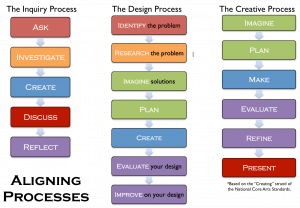Core Music Anchor Standards in Review
4 Min Read • National Core Arts Standards
Throughout this year, we’ve unpacked the Core Music Anchor Standards one by one. In this series, we’ve explored the big ideas of each anchor standard, how each of the eleven standards compare and contrast with the 1994 National Standards for Music Education, how we as arts teachers can make authentic connections to Common Core as well as to other arts contents, and how we can implement these new standards in our classrooms. Today, as a wrap-up to this series, I’d like to discuss a few takeaways I’ve gathered over the past 11 months.
-
Process is key.
The Core Arts Standards is based around four artistic process strands, which are common to all arts areas: creating, performing/presenting/producing, reflecting, and connecting. Within each of these process strands, there is an emphasis on guiding students to think critically and creatively about what it means to be an artist. What does it mean to be an artist? It means to create and present artistic work, to reflect on the work of others, and to make connections to the world around them. There is no complacency within the standards, but rather, a push to make observations and justify artistic intent, to revise and refine artistic work, and to create work that is relevant and meaningful.
Additionally, this creative process relates to the processes that are being explicitly taught in many STEM/STEAM classrooms: the processes of inquiry-based learning as well as the engineering design process. In the graphic below, you can see how although the sequence of these steps might differ from one process to another, there are parallel steps in each process. (Click to download the Aligning Processes Graphic.)

-
Connections are everywhere.
Connections among the five arts areas (music, visual arts, drama, dance, and media arts) are built right into the NCAS in that all areas share anchor standards, as well as four process strands. This signifies that the arts have an impact on one another, and that regardless of your arts area, we are all connected.
In connecting the arts to Common Core ELA Standards, works of art can serve as text, and this opens up a world of connections. We can ask students to dig into a musical work the same way we would ask them to deconstruct a written text. Additionally, if music is its own language, music is related to writing in that musically proficient students should be able utilize the organizational features of music to express their musical ideas. Students should be able make intentional, effective choices in intent, organization, and content, and then music revise, edit, and improve their creative ideas.
-
Always dig deeper.
The most significant change between the 1994 National Standards for Music Education and the National Core Arts Standards is that there is now an upward spiral of complexity within each anchor standard that allows students to experience a standard from year to year with increasing complexity and rigor. In addition, the new Core Arts Standards increase the depth and rigor of our students’ arts education by asking them to support opinions, observations, and connections with a level of evidence that we didn’t explicitly ask for in the 1994 standards. Students are expected apply knowledge of concepts and ability to think critically, listen to, analyze, apply feedback and develop criteria not only to the musical creations and performances of others, but to their own creative ideas and performances as well. Whenever possible, integrate inquiry and effective questioning strategies into your music classroom!
-
Find authentic contexts.
The National Core Arts Standards don’t just strive to teach arts content- they strive to build artistic thinkers. For this to be most effective, students should be able to connect what they do in arts classes with the world around them. The enduring understandings and essential questions built into the standards provide the why and the how of what we are asking of our students. When we allow students to take ownership of their artistic ideas learning, we elevate them from being one who simply learns the arts to one who is an artist.
-
You are already doing it!
So many pieces of the new Core Arts Standards have been part of the best practice music classroom for years. The new standards simply provide consistency and accountability. Find consistencies between the 1994 standards and the NCAS (standards 1 through 5 of the 1994 standards are particularly nicely aligned with the Core Arts Standards: students will still sing, perform on instruments, improvise, compose, read, and notate), and gradually increase the rigor and relevance of your music and arts instruction by focusing in on the verbs in the grade-level content standards. These verbs (i.e., explore, create, select, organize, revise, demonstrate) will help you ensure authenticity in your instruction by helping you get to the root of what the standard is truly asking of students.
You can find the articles that break down each of the Anchor Standards for Music by clicking the links below:



